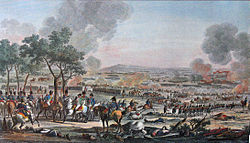Carle Vernet
At the age of five, he showed an extraordinary passion for drawing horses, but went through the regular academic course as a pupil of his father and of Nicolas-Bernard Lépicié.
[1] In his "Triumph of Aemilius Paulus", Vernet broke with tradition and drew the horse with the forms he had learnt from nature in stables and riding schools.
[citation needed] His drawings of Napoleon's Italian campaign won acclaim as did the Battle of Marengo, and for his Morning of Austerlitz Napoleon awarded him the Legion of Honour,[1] and Louis XVIII of France awarded him the Order of Saint Michael.
Just days before his death at the age of seventy-eight, he was seen racing as if he were a sprightly young man.
[1] In Maria Wirtemberska's novel Malvina, or the Heart's Intuition (1816; English translation 2001, by Ursula Phillips), it is said that a view that is being described merits the talent of Vernet, who as the writer explains in her own footnote was a sea painter.

